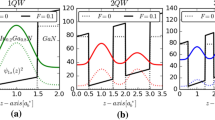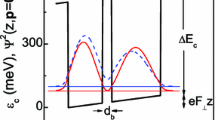Abstract
We study the energy spectrum of the impurity states in tunnel-coupled double quantum wells for Coulomb and short-range donor potentials. We calculate the impurity contribution and the density of states and detect the transformation of a localized donor state into a resonant state when the binding energy of the donor in an isolated quantum well is less than the separation of the energy levels of the double quantum wells. In the opposite case, where the binding energy is greater than the level separation, there is tunneling repulsion between adjacent impurity levels, with the degree of degeneracy of the levels changing when there is tunneling mixing of the ground and excited impurity states from different wells. Resonant states emerge in an asymmetric double quantum well, while in a symmetric double quantum well the impurity level at the barrier’s center proves to be localized even against the background of the continuum. The calculations are based on a general expression for the impurity contribution to the density of states in terms of a 2-by-2 matrix Green’s function, i.e., only a pair of tunnel-coupled levels of the double quantum wells is taken into account. For an impurity with a short-range potential, we derive a matrix generalization of the Koster-Slater solution, while the impurity with a Coulomb potential is analyzed by using the approximation of a narrow resonance and close arrangement of the repulsive levels.
Similar content being viewed by others
References
J. P. Eisenstein, Superlattices Microstruct. 12, 107 (1992).
T. Ohno, H. Sakaki, and M. Tsuchiya, Phys. Rev. B 49, 11492 (1994).
Y. Berk, A. Kamenev, A. Palevski, L. N. Pfeiffer, and K. W. West, Phys. Rev. B 51, 2604 (1995).
I. V. Butov, A. Zrenner, G. Abstreiter, A. V. Petinova, and K. Ebert, Phys. Rev. B 52, 12153 (1995).
Y. Huang and C. Lien, Phys. Low-Dim. Struct. 4/5, 1 (1995).
M. F. Krol, R. P. Leavitt, J. T. Pham, B. P. McGinnis, and N. Peyghambarian, Appl. Phys. Lett. 66, 3045 (1995).
V. B. Timofeev, A. V. Larionov, P. S. Dorozhkin, M. Bayer, A. Forchel, and J. Straka, JETP Lett. 65, 877 (1997).
A. M. Stoneham, Theory of Defects in Solids: Electronic Structure and Defects in Insulators and Semiconductors, Clarendon Press, Oxford (1975); J. Bourgoin and M. Lannoo, Point Defects in Semiconductors II. Experimental Aspects, Springer-Verlag, Berlin (1983).
R. L. Greene and K. K. Bajaj, J. Vac. Sci. Technol. B 1, 391 (1983).
R. Ranganathan, B. D. McCombe, N. Nguyen, Y. Zhang, M. L. Rustgi, and W. J. Schaff, Phys. Rev. B 44, 1423 (1991).
A. B. Dzyubenko, Zh. Éksp. Teor. Fiz. 113, 1446 (1998) [JETP 86, 790 (1998)]; A. B. Dzyubenko and A. L. Yablonskii, JETP Lett. 64, 213 (1996).
G. W. Bryant, Phys. Rev. B 47, 1683 (1993).
A. M. Fox, D. A. B. Miller, G. Livescu, J. E. Cunningham, and W. Y. Jan, Phys. Rev. B 44, 6231 (1991).
D. Y. Oberli, G. Bohm, G. Weinmann, and J. A. Brum, Phys. Rev. B 49, 5757 (1994).
S. Glutsch, F. Bechstedt, and D. S. Chemla, in Proc. 23rd Int. Conf. on Phys. Semicond., M. Scheffler and R. Zimmermann (eds.), World Scientific, Singapore (1996).
D. Birkedal, K. El. Sayed, G. Sanders, C. Spiegelberg, V. G. Lyssenko, C. Stanton, J. M. Hvam, V. B. Timofeev, and M. Bayer, Phys. Rev. B 54, 10 316 (1996); G. Kh. Tartakovskii, V. B. Timofeev, V. G. Lysenko, D. Birkedal, and J. Hvam, Zh. Éksp. Teor. Fiz. 112, 1106 (1997) [JETP 85, 601 (1997)].
E. N. Economou, Green’s Functions in Quantum Physics, Springer-Verlag, Berlin (1983).
A. Yariv, C. Lindsey, and U. Sivan, J. Appl. Phys. 58, 3669 (1985); F. T. Vas’ko and O. É. Raichev, Zh. Éksp. Teor. Fiz. 107, 951 (1995) [JETP 80, 539 (1995)].
F. T. Vasko and O. E. Raichev, Phys. Rev. B 50, 12 159 (1994); 51, 7116 (1995).
J. Galbraith and G. Duggan, Phys. Rev. B 40, 5515 (1989).
M. Bayer and V. B. Timofeev, Phys. Rev. B 54, 8799 (1996).
L. Shazhong and J. B. Khurgin, Phys. Rev. B 46, 12 535 (1992).
V. Takahashi, Y. Kato, S. Fukatsu, Y. Shivaki, and R. Ito, J. Appl. Phys. 76, 2299 (1994).
Author information
Authors and Affiliations
Additional information
Zh. Éksp. Teor. Fiz. 115, 1337–1352 (April 1999)
Rights and permissions
About this article
Cite this article
Vas’ko, F.T., Pipa, V.I. Donor states in tunnel-coupled quantum wells. J. Exp. Theor. Phys. 88, 738–746 (1999). https://doi.org/10.1134/1.558851
Received:
Issue Date:
DOI: https://doi.org/10.1134/1.558851




